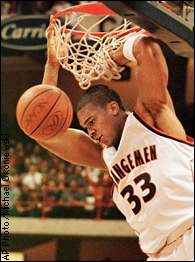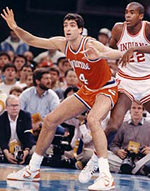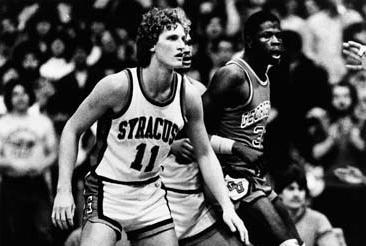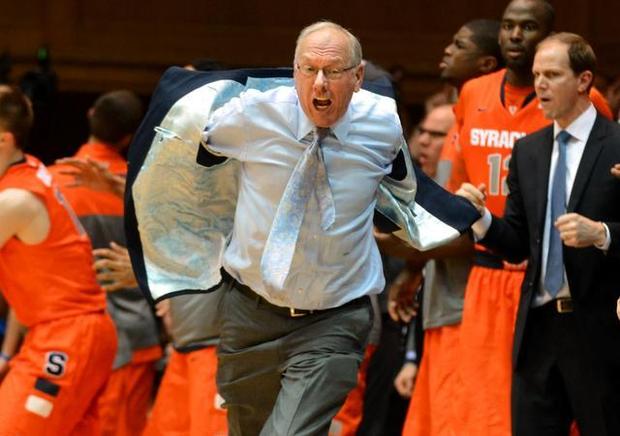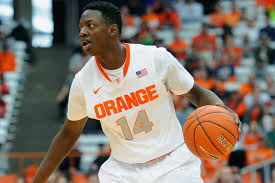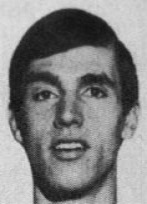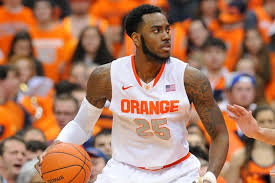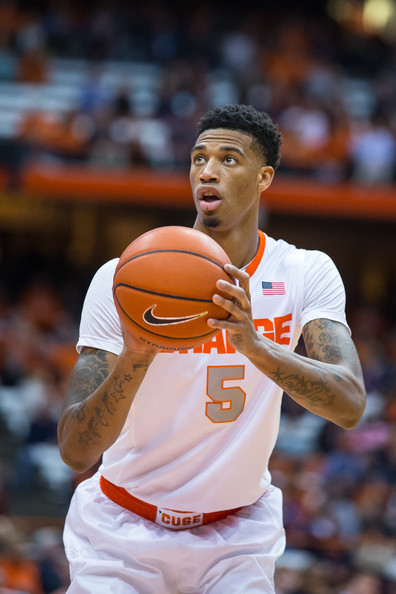In 2007, OrangeHoops inducted its charter class into the OrangeHoops Hall of Fame: Dave Bing, Derrick Coleman, Sherman Douglas, Vic Hanson, and Pearl Washington. The next six years saw the addition of Billy Owens (2008), Billy Gabor (2009), Lawrence Moten (2010), Louis Orr (2011), Roosevelt Bouie (2011) John Wallace (2012), Rony Seikaly (2013) and Vinnie Cohen (2014). So the list now stands at 13. Another year has passed, and now it is time for the 2015 inductee.
I established my rules for the OrangeHoops Hall of Fame back in 2007 and you can catch up on them here. 2015 does have four new eligible candidates (using the fifteen year rule): Jason Hart, Tony Bland, Ryan Blackwell, and Etan Thomas
Jason Hart was a four year starting point guard at Syracuse. He was an outstanding defensive guard with great quickness. He was a decent scorer and playmaker though prone to some poor decision making. He was All Big East First team his senior year, and finished his career as SU's all-time leader in steals and second in assists.
Tony Bland was a shooting guard for Syracuse who played for the Orangemen for two seasons. He was the starter his sophomore year, though he averaged only 20 minutes per game as the Orangemen had a lot of talent at the guard position. He would transfer to San Diego State after his sophomore year where he would then be a two year starter and would lead the Aztecs in scoring his senior year.
Ryan Blackwell was a starting forward for Syracuse for three seasons. He started his career at Illinois but transferred to Syracuse after his freshman year. He was a good all around player, though stronger on the defensive end of the court than the offensive end.
Etan Thomas was an outstanding defensive center for Syracuse for four seasons. He played both forward and center his freshman year, and was the starting center his last three years. Thomas was an outstanding shot blocker and developed into a terrific rebounder. He was highly efficient on offense, and developed a series of low post moves by his senior year that made him a terrific scorer in Syracuse's slow down offense. Thomas was the Big East Defensive player two years in a row, and was All Big East First team his senior year.
Two of the candidates from 1999-2000, Hart and Thomas, would make my list of top 10 eligible candidates.
Two of the candidates from 1999-2000, Hart and Thomas, would make my list of top 10 eligible candidates.
I think this year’s viable top 10 candidates come down to the following, listed chronologically: Lew Castle, Joe Schwarzer, Lew Andreas, Jon Cincebox, Jimmy Lee, Rudy Hackett, Leo Rautins, Stephen Thompson, Jason Hart and Etan Thomas.
Castle was a two time All-American at Syracuse, and was captain and leading scorer of Syracuse’s only undefeated team, the 1913-1914 squad that went 12-0.
Schwarzer was a two time All-American, and was captain and leading scorer of the 1917-1918 squad that went 16-1 and was retroactively named the National Champions by the Helms Foundation.
Andreas coached Syracuse basketball for 27 seasons, including the 19-1 1925-1926 squad that was awarded the Helms Foundation National Championship. He had a career record of 358-134, and he was the Syracuse Athletic Director for 28 years (1937-1964).
Cincebox was on the best rebounders in Syracuse history (in an era when rebounding numbers were admittedly high). He helped Syracuse to the NCAA Elite Eight in 1956-1957, as the dominant big man for the Orangemen.
Lee was a clutch shooter with terrific perimeter range, and outstanding free throw shooting ability. He was able to use his shooting ability to set himself up as a solid passer. Lee's 18 foot jumper with five seconds remaining led the Orangemen to beat heavily favored North Carolina, as the Orangemen eventually moved on to their first NCAA Final Four. Lee would end up making the All-Tournament team for his outstanding performances.
Lee was a clutch shooter with terrific perimeter range, and outstanding free throw shooting ability. He was able to use his shooting ability to set himself up as a solid passer. Lee's 18 foot jumper with five seconds remaining led the Orangemen to beat heavily favored North Carolina, as the Orangemen eventually moved on to their first NCAA Final Four. Lee would end up making the All-Tournament team for his outstanding performances.
Hackett was a powerful forward who could run the court well. He was a great rebounder and terrific scorer near the hoop. He led the Orangemen in scoring his senior year and helped lead Syracuse to its first Final Four in 1975.
Rautins was a terrific ball-handling forward with a nice shooting touch, solid rebounding and scoring skills. He is most well known for his game winning tip in basket to win the Big East Championship in triple overtime against Villanova in 1981. Rautins also recorded two triple-doubles in Big East action.
Thompson was an explosive swingman, with incredible quickness and vertical leap, and excellent defensive skills. He was extremely adept at playing above the basket though he was only about 6'2". He teamed with Sherman Douglas to perfect the alley-oop basket. Thompson was an extremely proficient scorer, despite the fact he was a terrible perimeter shooter.
Rautins was a terrific ball-handling forward with a nice shooting touch, solid rebounding and scoring skills. He is most well known for his game winning tip in basket to win the Big East Championship in triple overtime against Villanova in 1981. Rautins also recorded two triple-doubles in Big East action.
Thompson was an explosive swingman, with incredible quickness and vertical leap, and excellent defensive skills. He was extremely adept at playing above the basket though he was only about 6'2". He teamed with Sherman Douglas to perfect the alley-oop basket. Thompson was an extremely proficient scorer, despite the fact he was a terrible perimeter shooter.
All are worthy players, and tough selections to make. I designed my selection rules to make it tough; the Hall of Fame should be the 'best of the best', and I would rather have a line of worthy players outside the Hall of Fame, than cheapen it by having lessor players included.
This may be the toughest pick for me in all the years so far. Ten very good candidates, and a couple of those players are among my all-time personal favorites. My 2015 inductee is Etan Thomas.
Thomas is perhaps the best defensive center in Syracuse history, which would give him a nod over Rony Seikaly and Roosevelt Bouie. He was the anchor on an outstanding defensive Syracuse team for four seasons, and helped them rise to #4 in the polls during the mid season of his senior year.
Thomas was the 12th overall pick in the 2000 NBA Draft by the Dallas Mavericks. He would be traded to the Washington Wizards and spend most of his career there. Thomas was a solid reserve player for most his career, and missed the 2007-2008 season due to open heart surgery.
Thomas would also become an author and a poet.
Congratulations to Etan Thomas, the 2015 Inductee into the Orange Hoops Hall of Fame.
